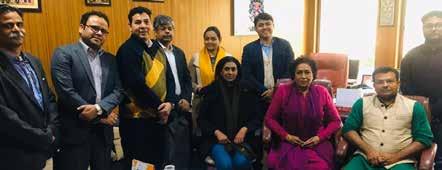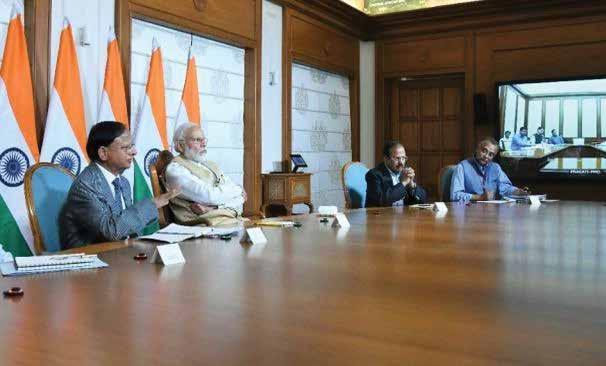
9 minute read
Pin Point
Inside
Volume 5, Issue 12 April 2020
Advertisement
6 10
Pin Point Newscan
15 46
City Image Urban Agenda
Cover Story 22 Cities in time of Corona Cities have donned a novel appearance that none of us has ever seen. We wish we need not see it ever again. COVID-19 has claimed over 150, 000 lives, infected over 2,200,000 people, and affected almost everyone on the planet in one way or the other. Cities may be the worst affected but our urban institutions are also giving a glimmer of hope to humanity in this fight against COVID-19
Arti le 28 A history of pandemics & shape of human history
32
Nature gets some breathing space, but for how long?
34
Economics of health; health of economies
EVE NT 38 Cities assure to accelerate efforts to achieve SDGs in 5 th SAC Summit 42 ‘Gender equality should be the top priority of cities’
Le der pe k 26 Scaling up innovation in sanitation to mitigate risks from pandemics like COVID-19 AIILSG stands with the nation and urban local bodies in particular in the time of coronavirus pandemic. Our institute is committed to extending all kind of support to our municipalities in this fight. Sanitation has been the prime focus for our institute since its inception. This COVID 19 pandemic has compelled us to rethink our community sanitation standards and redesign our curriculum for sanitation workers

27
This is a time for science and solidarity. Wild conspiracy theories are infecting the Internet... I salute the journalists and others fact-checking the mountain of misleading stories and social media posts. Together, let’s reject the lies and nonsense out there
Antonio Guterres
UN Chief
The one thing we absolutely know for sure is that social distancing measures works. It leads to a situation where every case is infecting less than one other case, and that means if you keep the course, you’ll get transmission essentially down to zero.
Dr Christopher Murray
Institute for Health Metrics & Evaluation, University of Washington
PIN POINT
The economic effect of this is really dramatic. Bringing the economy back ... that’s more of a reversible thing than bringing people back to life. So we’re going to take the pain in the economic dimension to minimize the pain in the diseases-and-death dimension
Bill Gates
Co-Founder, Microsoft Corporation
Were we ready for this crisis? Clearly not ready enough, but we have faced up to it. We had to adapt constantly because this virus was unknown and even today much about it remains mysterious. Let’s be honest: Events revealed weaknesses, deficiencies
Emmanuel Macron
President of France
BUZZ
Ram Nath Kovind President, India @rashtrapatibhvn
The President emphasised the need to ensure that no one remains hungry during the lockdown. Taking note of the problems faced by the homeless, the unemployed and the weaker sections of society during this crisis, he said we will have to be extra sensitive towards their needs
Amnesty International @amnesty
Health workers around the world are putting their lives at risk, to save ours. If health workers are not protected, neither are we. We ask: Protect health workers, protect everyone
Arvind Kejriwal Chief Minister, Delhi @ArvindKejriwal
PM has taken correct decision to extend lockdown. Today, India’s position is better than many developed countries because we started lockdown early. If it is stopped now, all gains would be lost. To consolidate, it is imp to extend it
Ratan N Tata Chairman Emeritus, Tata Sons @RNTata2000
The COVID 19 crisis is one of the toughest challenges we will face as a race. The Tata Trusts and the Tata group companies have in the past risen to the needs of the nation. At this moment, the need of the hour is greater than any other time
Capacitating CSOs & Empowering Wo men & Girls through Soc ial Entrepreneurship
All India Institute of Local Self-Government along with its partners is awarded the Girl Power project by European Union to work on overall development and empowerment of CSOs working on women and girls support in the state of Jharkhand
harkhand is one of the poorest states in India. Created in 2000, Jharkhand has 39.1% poverty headcount and a gross state domestic product of (GSDP) of US $589 (2010-11). The state boasts a population of 33 million, of which 76% is rural and the share of vulnerable groups is high at 12% Scheduled Castes and 26% Scheduled Tribes. Within this context, the effective literacy rate for Jharkhand in Census 2011, works out to 67.63% with corresponding figures for males and females being 78.45 and 56.21 respectively, with at least 10 districts being below 50%. The population is also very young. adolescents and youth (ages 10-24) constitute 31% of the total population. It is an estimated 56% of young women (ages 15-24) are neither engaged in education, nor employment or training. This is further accentuated by lags in female education. It is estimated that beyond schooling, only 8% of young women age 18-24 ever participated in some form of training, and less than 0.1% had secured a vocational training diploma.
The Girl Power project aims to bring about overall development and empowerment of CSOs working on supporting women and girls in the J

state of Jharkhand using a combination of training, skill building, network formation, policy dialogue, market access and entrepreneurial support. The project has been awarded by the European Union to AIILSG and its project partners. AIILSG’s project partners are the renowned Mahatma Gandhi Institute for Rural Industrialization (MGIRI), Magan Sanghralaya Samiti (MSS: the only museum established by Mahatma Gandhi) and Saunta Gaunta Foundation (SG Foundation).
The CSOs in Jharkhand are ill-equipped and poorly represented to undertake this exercise due to lack of support and innovative models. This project will involve partners from within Jharkhand and outside with innovative models and best practices to build knowledge and capacities of CSOs by engaging meaningfully with social enterprises focusing on women and girls. At the same time, provide skills and competences for strengthening (Self Help Groups) and creating social enterprises for empowering women and girls & their entrepreneurship. On the other hand, social enterprises funding and support are largely focused around a start-up environment using scalable, replicable and financially sustainable projects and not on
gender empowerment by creating an ecosystem of growth using networks, capacity building, market access etc.
The project will be implemented with the development of Gender Network for Social Entrepreneurship Jharkhand, which will mostly comprise of CSOs. Another important aspect will be the creation of Jharkhand Mahila Social Entrepreneurship Market Connect (JMSEMC). This market connect will help the women social entrepreneurs to directly showcase their products and services. It will also help the women to monetize their products. The market connect will also be supported by a website which will help in promoting the entrepreneurs. Beyond these activities, skill-development for 5000 women and girls; course development; best practices forums will be regularly undertaken within the project scope.
This project will support the Government of India’s Skill India Mission and its agencies, namely, the National Skill Development Corporation (NSDC) and affiliated skill sector councils (SSCs) in imparting skill-based training to women. It will also support the National Urban Livelihood Mission (Skill Training and Placement (EST&P) and the National Rural Livelihood Mission of Government of India. Further, the project will support the Government of Jharkhand’s skill development initiatives especially the Skill Development Policy 2018 and vision plan which has undertaken a target to train 8.5 lakh youths in the next 3 years, that is till 2020-21, and 79,000 rural youth to be trained (over 30% women). Within this context, Jharkhand is supporting and heavily investing in Mega skill building centres – around 5 have been started in the state so far with specific focus on providing skill training to women and open employment avenues.
AIILSG has set up Skill Building Centres at Ranchi and Madhupur which are both functional.
Climate Resilient & Inclusive Cities

The CRIC project aims at building long lasting and unique cooperation between cities & research centres in Europe, Indonesia and other countries from South East Asia, and to contribute substantially to sustainable integrated urban development, good governance, climate adaptation, etc ith an urban growth averaging 4.4% annually, I n d o n e s i a experiences the highest rate of urbanisation in Asia (higher than in India and China). It is predicted that 68% of the population will live in cities in the next ten years . Urban population densities exceed 15,000 habitants/km² in cities like Jakarta and more than 30,000 habitants/km² in some inner-city areas. Cities are hardly hit by climate change, although they could be seeds for solutions. Cities like Jakarta are sinking below sea level and could be expected to sink by 2050. Countries like Vietnam (36% of urban population) and the Philippines (45%) concentrate large urban areas, with fast growing centres . Urban areas host most of the vulnerable populations, as well as vital and social W infrastructure, and local governments have increased pressure to develop services, infrastructure, employment (UN Habitat).
The overall objectives of the project is to propose a long lasting and unique cooperation between cities and research centres in Europe, Indonesia and other countries from South East Asia, and to contribute substantially to sustainable integrated urban development, good governance, and climate adaptation/mitigation through long lasting partnerships, and tools such as sustainable local action plans, early warning tools and experts panels. The Specific objectives ♦ To strengthen good governance ♦ The sustainable use of resources by cities ♦ Social cohesiveness and inclusive cities ♦ Resilience and actions for the environment ♦ Prosperity and Innovation in cities, innovation, ♦ culture, design, and the identification of sustainable financing mechanisms. ♦ The promotion of triangular cooperation
Hundreds of millions of people in poorer urban areas are hit by pockets of deprivation, and lack of basic infrastructure (such as water and sanitation). Problems will worsen when the most fragile territories could be affected by rising sea levels, flooding, landslides, toxic peaks of air pollution, typhoons alerts, storms, or periods of more extreme heats and droughts related to climate change. Cities and local governments are increasingly recognized as key actors in addressing climate challenges and SDGs. United Cities and Local Government Asia Pacific (UCLG ASPAC) as an association AIILSG team at the launching and kick off meeting of Climate Resilience Inclusive Cities Project of the local governments is the key actor as knowledge management hub on LGs’ issues in the Asia Pacific region. UCLG ASPAC has strong sources of leadership that require enabling frameworks and a combination of measures to achieve the changes that are needed.
Considering the urgency of the climate resilience issues, UCLG ASPAC initiated the Climate Resilience Inclusive Cities (CRIC) Project. It is a five (5) years project with overall objectives to propose a long lasting and unique cooperation through a triangular cooperation between cities and research centres in Europe, South Asia (India, Nepal, Bangladesh), and Southeast Asia (Indonesia, Malaysia, Philippines, Thailand). The Project will also contribute to sustainable integrated urban development, good governance, and climate adaptation/mitigation through long lasting partnerships, and tools such as sustainable local action plans, early warning tools, air quality and waste management in consultation with experts’ panels.
The target groups of the Project will be local governments, cities, urban stakeholders working on climate resilience, climate mitigation and adaptation, and good governance of inclusive cities. With final beneficiaries including but not limited to local community of the cities/provinces, including women, marginalised sector, civil society, and private sectors. Targeted Outcomes Pillar 1: Knowledge production and exchange Pillar 2: Local action plans for climate resilient and inclusive cities Pillar 3: Communication & Capacity Building









